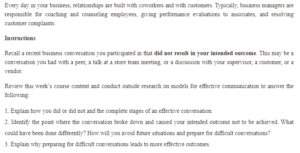Business Conversations
An effective conversation includes five stages. They have the message’s source, encoding, channel, decoding, receiver, and feedback. Recently, I used the effective conversation process to chat with a customer while operating a business. However, the conversation was not successful and broke down at some point. The customer had a problem communicating her needs, and I was left guessing. Upon suggesting various products to her, she got angry and left the shop premises. The conversation with the client started well because there was no language barrier. The customer had little grasp of English and shifted to using an unfamiliar language when communicating. I tried to use symbols to comprehend her needs, and since I was not conversant with symbol language, I suggested products to her by pointing at them. She got angry, and at this point, I realized the conversation had broken down and its intended intention could not be attained. I think in the future, the shop should provide different avenues through which customers convey their messages and how they get to respond.
Do you need an unpublished version of the “Business Conversations” ? Contact us.
One way to embrace effective conversations is by offering multiple channels for message transfer. Notably, this could have helped my communication with the customer to remain effective up to the end. For instance, the conversation could have offered the customer a platform where she could type her needs or speak to a computer that could record and interpret her language in English. As a result, I could have understood what she wanted and responded to her appropriately. As this is one way of preparing for difficult conversations, I believe more effective outcomes can be attained from preparing for difficult conversations. Preparing for a difficult discussion determines the purpose of the conversation. It helps adopt the right approach, plan the suitable exchange, change the held beliefs and assumptions, recognize and manage emotions, and open the conversation (Mills et al., 2021). All these critical aspects play a role in ensuring a conversation is compelling.
References
Mills, A., Knight, A., & Burdett, T. (2021). Supporting student nurses to develop healthy conversation skills. British Journal of Community Nursing, 26(11), 554-559.
ORDER A PLAGIARISM-FREE PAPER HERE
We’ll write everything from scratch
Question 
Every day in your business, relationships are built with coworkers and with customers. Typically, business managers are responsible for coaching and counseling employees, giving performance evaluations to associates, and resolving customer complaints.

Business Conversations
Instructions
Recall a recent business conversation you participated in that did not result in your intended outcome. This may be a conversation you had with a peer, a talk at a store team meeting, or a discussion with your supervisor, a customer, or a vendor.
Review this week’s course content and conduct outside research on models for effective communication to answer the following:
- Explain how you did or did not and the complete stages of an effective conversation.
- Identify the point where the conversation broke down and caused your intended outcome not to be achieved. What could have been done differently? How will you avoid future situations and prepare for difficult conversations?
- Explain why preparing for difficult conversations leads to more effective outcomes.
